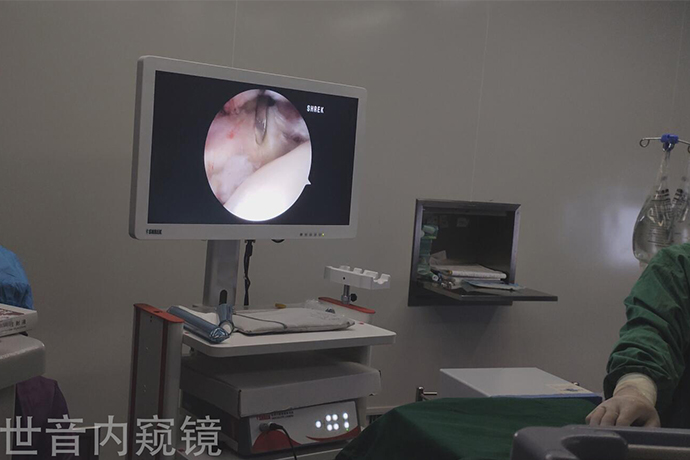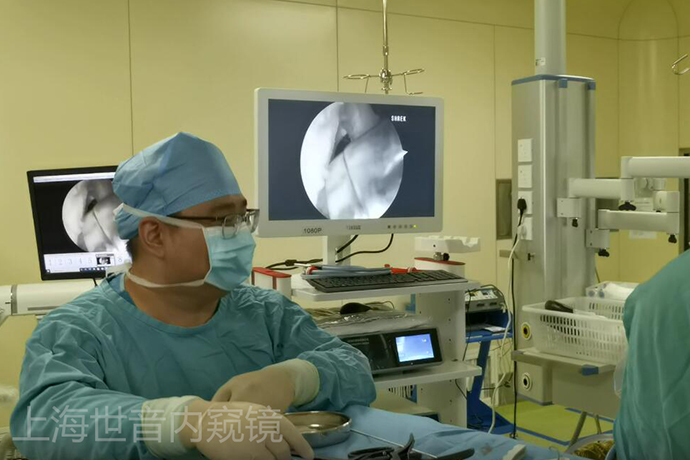【Orthopedic Arthroscopy】Intra-articular loose body removal
Release time: 26 Jul 2022 Author:Shrek
What is a Knee Loose Body?
Does it need to be taken out?
Knee joint loose body, also known as "joint rat", refers to the movable cartilage or osteochondral fragments in the joint, which is a common knee joint disease. Intra-articular loose bodies can be derived from cartilage, osteochondral, or synovial membrane, and can be completely free or connected by soft tissue bands. Clinically, loose bodies of the knee joint often appear joint interlocking phenomenon. Sudden joint interlocking occurs as smaller loose bodies are pinched between the articular surfaces. When present, the patient has severe pain, and the interlocking position is often unstable (sometimes in flexion without extension; sometimes in extension without flexion). Patients may experience joint swelling, fluid accumulation, weakness in the knee, or palpation of a movable mass as a result of a loose body swimming superficially due to mechanical irritation of the synovium of the knee. In addition, when the interlock is unlocked, the patient can hear or feel the sound, staggered movement, and some may even cause kneeling.

Patients with a loose body of the knee can often feel a hard object running around in their knee. When walking, sometimes I suddenly feel that the knee joint is stuck, and it is necessary to move the knee joint in order to extend and flex the knee joint normally.
The free body of the knee joint will wear down the cartilage of the knee joint in the knee joint, gradually exposing the subchondral bone, resulting in knee osteoarthritis, and the knee joint pain becomes more and more severe. Gradual development will lead to deformation of the knee joint, unable to straighten or bend, and unbearable pain, thereby losing the ability to work and even lose the ability to walk.
The most common cause of free body formation?
1. Osteoarthritis
Occurs in middle-aged and elderly patients, joint degeneration, aging, cartilage or osteochondral exfoliation. The exfoliated tissue accumulates in the joint, is nourished by the synovial fluid, and gradually forms loose bodies, and osteophyte fractures with osteoarthritis hyperplasia can also form loose bodies, especially the osteophyte fractures of the upper pole of the patella are prone to form loose bodies.
2. Osteochondritis dissecans
Occurred in young and middle-aged patients, it is the avascular necrosis and exfoliation of articular cartilage or subchondral bone under the action of repeated external forces or inflammatory reactions, resulting in the formation of loose bodies in the joint, which is called osteochondritis dissecans .
3. Patellar dislocation
Occurs in adolescents. At the moment of patella dislocation, the medial cartilage of the patella and the cartilage of the lateral femoral condyle collide, resulting in osteochondral damage.
4. Synovial chondroma
Should be differentiated from loose bodies, this disease is formed by synovial cartilage metaplasia. Characterized by the formation of cartilage nodules on the synovium, these cartilage corpuscles can reach dozens or even hundreds for a long time. They can grow with pedicles, protrude into the joint cavity, or fall off into the joint cavity and become loose bodies ( jointed rat). Generally, there are <3 loose bodies, and >3 synovial chondromas.
Therefore, joint loose bodies will appear in all age groups, and specific medical records need to be analyzed in detail. Of course, loose bodies are best found in middle-aged and elderly patients, and joint degeneration and aging are the pathogenic factors. The knee joint is worn out, the cartilage softens and falls off, gradually exposing the subchondral bone. As a result, knee osteoarthritis occurs, and the knee joint pain becomes more and more severe. Gradual development will lead to deformation of the knee joint, pain, and loss of working ability and even walking ability. Therefore, if a loose body of the knee joint is found, the loose body in the knee joint should be taken out as soon as possible, otherwise the wear and tear of the knee joint will become faster and faster, and the symptoms of pain will become more and more severe.
Where are loose bodies commonly found?
Loose bodies most commonly occur in the knee and elbow, and occasionally in the hip (femoral head) and ankle (talus). Among them, because the knee joint cavity is larger and more spacious, the loose body is better to take. The hip joint is very tight. Without traction, the arthroscope cannot be inserted into the joint cavity at all. What is even more difficult is that the loose body of the hip joint often appears in the inner and rear pockets, and the arthroscope and other instruments cannot be bent. In order to bypass the femoral artery, vein and nerve, it can only be inserted from the anterolateral side, so the loose body of the hip joint often cannot be completely removed.
Clinically, loose bodies of the knee joint often appear joint interlocking phenomenon. Sudden joint interlocking occurs as smaller loose bodies are pinched between the articular surfaces. When present, the patient has severe pain, and the interlocking position is often unstable (sometimes in flexion without extension; sometimes in extension without flexion). Patients may experience joint swelling, fluid accumulation, weakness in the knee due to mechanical irritation of the periosteum, or palpation of a movable mass due to loose bodies swimming superficially. In addition, when the interlock is unlocked, the patient can hear or feel the sound, staggered movement, and some may even cause kneeling.
Treatment of Knee Loose Body
The treatment of knee joint loose bodies can be divided into conservative treatment and surgical treatment.
1. Conservative treatment includes: for small loose bodies without obvious noose symptoms only found on imaging, conservative treatment can be used, oral non-steroidal anti-inflammatory drugs, to relieve arthritis reaction and pain. Eliminate swelling, local hot compress, physiotherapy, joint puncture, extraction of effusion, injection of sodium hyaluronate, preparation of PRP (platelet-rich plasma) intra-articular injection from autologous blood, etc., to relieve and improve symptoms.
2. Surgical treatment: Because of the advantages of less trauma, less pain, less bleeding, faster recovery and shorter hospital stay, arthroscopic minimally invasive treatment has been widely used in clinical practice in recent years.
Overview
In this minimally invasive procedure, the surgeon removes fragments from the knee joint. These fragments are usually pieces of bone, cartilage, or other tissue that have broken free and float in the joint.
Prepare
When preparing for surgery, first apply anesthesia. Clean the knee joint with disinfectant.
Expose the joints
The surgeon makes several small openings in the knee joint. Arthroscopes and various arthroscopic instruments are inserted through these openings.
Clean up the joints
The surgeon carefully examines the joint, looking for signs of damage or debris. The patient may have one or more loose bodies floating in the joint. The surgeon removes debris from the knee joint with a grasping tool. The surgeon can also make some repairs if the debris damages any surface in the joint.
End of surgery and post-operative care
After the surgery, the instruments are removed, the incision closed and bandaged. The knee joint will gradually heal over the next few weeks.

- Recommended news
- 【General Surgery Laparoscopy】Cholecystectomy
- Surgery Steps of Hysteroscopy for Intrauterine Adhesion
- [Gynecological Hysteroscopy] Techniques for Preventing and Treating Complications of Hysteroscopic Surgery
- [Gynecological Hysteroscopy] Hysteroscopic Adhesiolysis
- [Gynecological Hysteroscopy] IUD Removal under Hysteroscopy